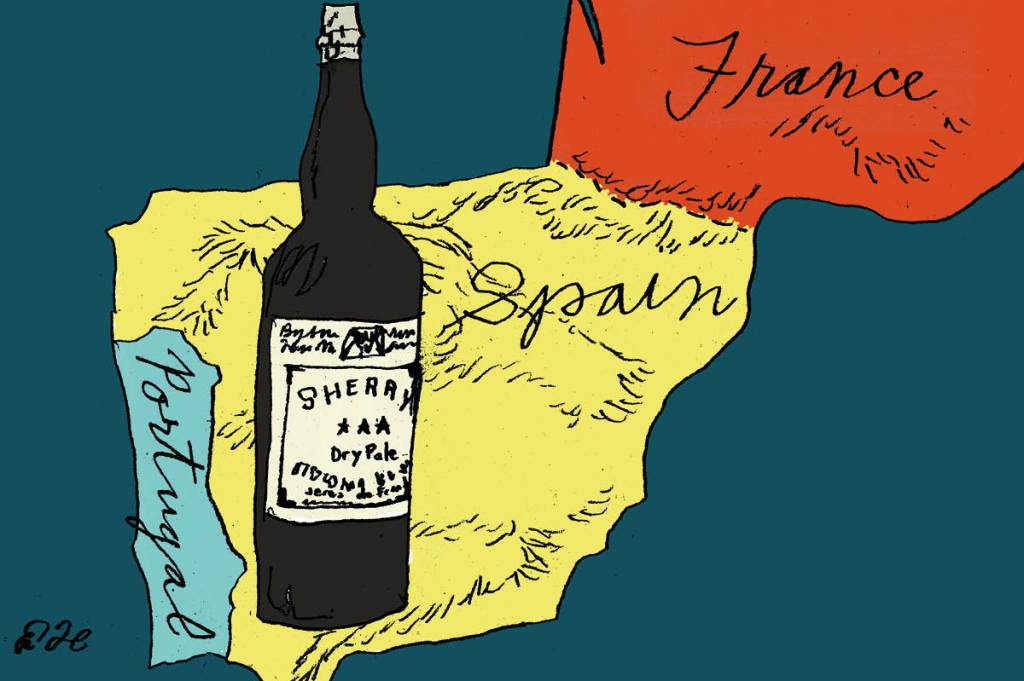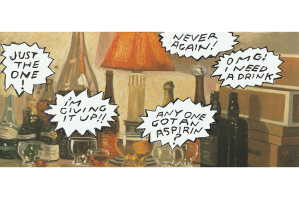Early on in his classic Notes on a Cellar Book, the literary scholar George Saintsbury writes that “no reasonable person should quarrel if we begin with Sherry, even as the truly good and wise usually do at dinner.”
That was in 1920. Can you imagine anyone writing that today? The answer is no. But that only tells us how fickle are the revolving fashions of taste. For us, Sherry is an antique taste, quaint if not fusty. By and large it’s something that maiden aunts drink between knitting projects and jumble sales.
At its best, Sherry has a fading academic aroma. When I was in graduate school, I had a semester-long tutorial on Plato with the eminent Platonist Robert Brumbaugh. We’d meet in his office at 11:00, talk about Plato for an hour and a half, then partake of a glass of Sherry before repairing to the dining hall for luncheon. I’m told that most everything about those sessions would be against the rules if not actually illegal now. It was just the two of us in his office — how elitist! — and the door was closed. I don’t remember whether I was twenty-one yet, but in any event, teachers are not supposed to proffer alcoholic beverages to their charges these days.
All those interdictions are a fit subject for another day, but what about the beverage itself? In fact, it is the perfect mid-afternoon tipple: clean, light, delicate. It would be paltering with the truth to say I remember what sort of Sherry it was, but in my imagination it has to have been a Fino — Spanish for “delicate” — or an Amontillado, my favorite in college at least in part because of its starring role in Edgar Allan Poe’s story “The Cask of Amontillado” (“The thousand injuries of Fortunato I bore as I best could. But when he ventured upon insult, I vowed revenge!”).
Well, my point is that if Sherry languishes in the outer courtyard of fashion today, there once a time — and it was a long, long time — that it stood in the innermost sanctum. Sir John Falstaff, for example, swilled it as others quaff water, though he called it “sack” or “sherris sack.” He delivers himself of an encomium to the drink in the fourth act of Henry IV, Part 2: “If I had a thousand sons, the first humane principle I would teach them should be, to forswear thin potations and to addict themselves to sack.”
Sherry comes from Andalucía, in southwest Spain. Its name can be traced back to the Phoenicians, who as far back as 1100 BC made wine in the area they called “Xera,” which the Romans later called “Ceret.” The Moors, who held the lease in that area for about 500 years, valued the grapes for the raisins they yielded. They called the place “Sherish” or “Seris,” which became “Xeres” in 1264 when the Christians moved in.
There are four things to know about Sherry. The first has to do with the soil. The chalky white, water-retentive soil where the best stuff comes from is called “Albariza.” It is a similar glacial deposit to that which stretches underneath Champagne and Chablis across the English Channel to Devon.
The second thing to know is that the primary grape is called “Palomino”: a white grape that is capable of an extraordinary spectrum of tastes and aromas.
The third thing to know is that Sherry is a “fortified wine.” A dollop of wine spirit is added immediately after fermentation to boost the alcohol from about a 15.5 percent to nearly 20 percent, depending on the style of Sherry.
The fourth thing to know is most Sherry is by nature bone-dry. This may seem surprising because the overwhelming majority — 70 percent or more — of Sherry sold is semi-sweet or sweet “cream” or “milk” sherry, a taste achieved by the addition of Pedro Ximénez (“PX”) or Moscatel grapes to the blend. I think of those wines as afternoon potations. But the dry varieties — the Finos and Manzanillas (a more ethereal style of Fino) are excellent food wines.
I went recently with a small group of serious thinkers to Casa Mono on Irving Place and 17th Street in New York. I have mentioned their excellent selection of red wine in this column before. But our current expedition was in search of Sherry. We were fortunate to encounter James, a sommelier as companionable as he was knowledgeable, who was our cicerone as we wended our way from light to dark: from a selection of Finos and Manzanillas, through Amontillado — darker, nuttier — to the richer, more caramel Palo Cortados and Olorosos (“scented” in Spanish).
I have come near the end of my space without mentioning three critical things: that almost all Sherry is the product of a complicated blending process (the so-called “Solera” process), so the idea of vintage Sherry (though it does occur) is rare; that the reason that Fino and Manzanilla are bone-dry is because it is aged under a naturally occurring film of yeast (“flor”), which keeps the oxygen away from the wine; and, finally, that Sherry is still a great bargain, excellent examples of which (by Tio Pepe, for example, or Lustau) can be had for $20-$40.
There’s always more to say, but I think that it is now time for a glass of Fino or Amontillado to brighten these increasingly brief and chilly days.
This article was originally published in The Spectator’s December 2023 World edition.


























Leave a Reply